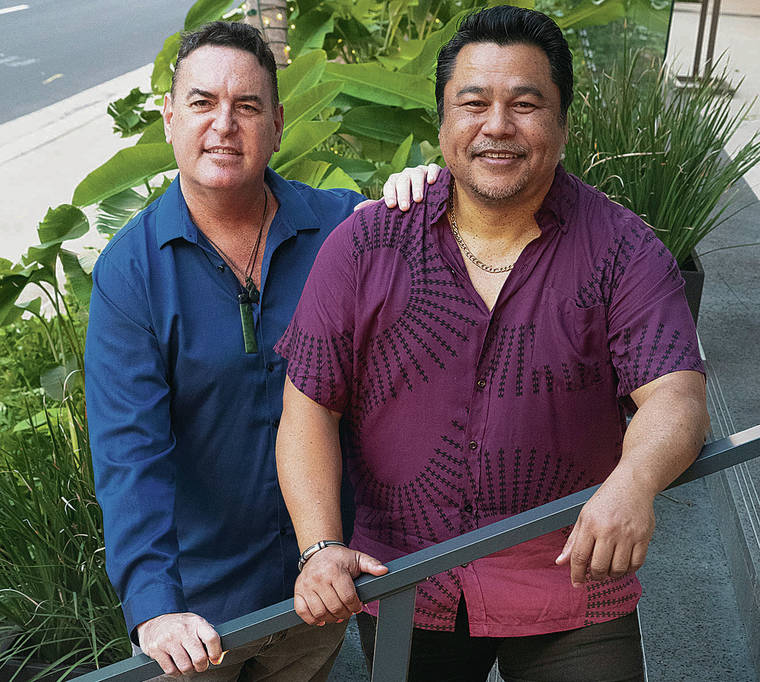In 1986, Horace K. Dudoit III and Manu Boyd formed Kipona Leo Hawai‘i with William “Ama” Aarona and Chris Kamaka to compete in the Ka Himeni ‘Ana Hawaiian singing competition — and won.
Three years later Dudoit, Boyd and Aarona formed Ho‘okena with Glen Smith and “Bozo” Hanohano to “quench the thirst” for Hawaiian rather than Jawaiian music. The group’s first album, “Thirst Quencher!,” won three Na Hoku Hanohano Awards — group of the year, traditional Hawaiian album of the year and most promising artist(s) — in 1991.
More than 30 years later Ho‘okena is still quenching Hawaii’s thirst. The group has released 13 albums and has received seven Na Hoku Hanohano Awards with an eighth going to Boyd in 2010 for his work as a songwriter. They are also three-time Grammy Award finalists, most recently in 2018 when “Ho‘okena 3.0” was one of the five finalists in the best regional roots music category.
Hanohano left after the first two albums. Kamaka joined in 1999, Aarona retired in 2003 and Boyd left for a successful solo project in 2012. From 2012 until last December, Ho‘okena was a successful self-contained trio. Then came a sold-out, two-show reunion with Aarona and Boyd at the Blue Note Hawaii.
In March they met to talk about recording as a quintet. Dudoit, 56, and Boyd, 58, celebrated the official release of the new album, “Meant to Be,” earlier this month.
Many people have missed the sound of Ho‘okena as a quintet. What got you back together?
Dudoit: We were supposed to do the Blue Note as a trio with Maila (Gibson-Bandmann), but they changed the date and she couldn’t do it. Chris and I called Ama and Manu to join us. They said “yes,” and we sold out two shows.
Boyd: We’ve always been friends, so that’s not the issue. Chris had called me a couple of months before to ask me to write a song for his daughter. I was super nervous at the event but it was a great show. The feeling was really, really good. I don’t know what the timing was all about (because) next year will be 35 years (since Ka Himeni ‘Ana), but like the title of the album, it was meant to be. And when we started the album we didn’t even have that song. My kumu (Robert Cazimero) wrote it later for Glen to sing.
How did it feel to be back recording with the “old” Ho‘okena?
Dudoit: The neat thing about everything was the sound that we still had after that time frame. Everything fell in place. All the parts, the harmonies. The first (recording) session we covered nine songs on instrumentals. The next day we did the vocals for four.
Boyd: It was literally “meant to be.” I think it’s a blessing that we are able to do this.
What is one of your most lasting memories about the project?
Boyd: After we thought we were done with “Moloka’i ‘Aina Kaulana,” we sent a rough draft to Nina Keali‘iwahamana (so she could hear it). So Nina calls Horace and says, “Oh darling, I so appreciate the beautiful recording of ‘Moloka’i ‘Aina Kaulana,’ but let me share with you how Mama (Vicki Ii Rodrigues) taught us to sing the melody.” There were some very subtle differences. We were very close, but not close enough.
Dudoit: We were “done” with that recording, but I called the engineer and told him we had to get in (to the studio) the next day. And we did.
The album is out. You won’t be doing live shows for a while. What’s next?
Boyd: I’m ready to do another album. I have all kinds of mele that we haven’t recorded. I actually prefer old mele that other people wrote who I admire to (singing) my own. When I’m performing with other people I never sing my own songs.
Dudoit: I tell him we need to recover (production expenses) first.
What is the biggest change for you as Hawaiian recording artists since the first Ho‘okena album was released in 1990?
Dudoit: Social media. Back then there was no “social media.” Now we have Allan Cool getting us out there in the social media world worldwide.
—
ALBUM REVIEW
Collection revives old-time harmonies
“Meant to Be”
Ho‘okena
(Huliau)
One of the year’s most anticipated Hawaiian recordings lives up to expectations as Ho‘okena welcomes returnees Manu Boyd and William “Ama” Aarona for a musical rebirth of the group as it was at the turn of the century. (Since 2012, Ho’okena has been Horace K. Dudoit III, Chris Kamaka and Glen Smith.) The old-time, five-part harmonies are as full and smooth as they were “back when.” Hearing Boyd’s voice as he takes a solo brings back fond memories as well.
Ho‘okena excels at interpreting Hawaiian standards. Several newly written songs fit in seamlessly. Dudoit and Boyd collaborated on a song for Dudoit’s first grandchild. A second, written by Boyd, commemorates the marriage of Kamaka’s daughter. A third Boyd song, this one recalling the names of the rains and winds in different parts of Honolulu, almost certainly contains “kaona” (hidden meanings) within its lyrics.
The quintet switches to English for the title song. Sung by Smith and written by kumu hula Robert Cazimero, it displays their command of contemporary hapa haole music.
Ho‘okena completes this beautiful collection with liner notes that provide the Hawaiian lyircs, English translations and background information on each song.
Visit hookena.com.




